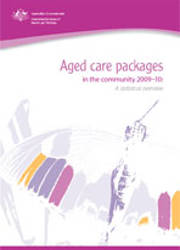Summary
This report presents statistics about three types of community aged care packages—Community Aged Care Packages (CACP), Extended Aged Care at Home (EACH), and Extended Aged Care at Home Dementia (EACHD)—over the period 1 July 2009 to 30 June 2010. These packages provide an alternative form of care to residential aged care and are provided to recipients in their own homes.
Increased supply across all three packages
- At 30 June 2010, there were about 40,100 CACP clients, 5,250 EACH clients and 2,300 EACHD clients. Compared with the number of clients at 30 June 2009 this represents a 5% increase in CACP clients, a 26% increase in EACH clients and a 23% increase in EACHD clients.
- The number of packages available also increased over the 12 months to 30 June 2010: CACP numbers increased by 2,400 to a total of 43,300 packages, EACH numbers rose by 1,100 to almost 5,600, and EACHD increased by 660 packages to give a total of nearly 2,600. The provision ratio for CACP, EACH, and EACHD (24.4 places per 1,000 people aged 70 years and over) is close to the Australian Government target for community care places to be achieved by 30 June 2011 (25 places per 1,000). This target also requires that four of these places must be for high care. The combined EACH and EACHD provision ratio (high-care places) at 30 June 2010 was 3.9 places per 1,000 people aged 70 years and over.
Aboriginal and Torres Strait Islander people access services at younger ages
- Aboriginal and Torres Strait Islander people had higher usage at younger ages compared with those that did not identify as Indigenous. For CACP, Indigenous people aged 60–64 years used packages at the rate 16.7 per 1,000 population compared with 0.6 per 1,000 for non-Indigenous people.
- A much higher proportion of Aboriginal and Torres Strait Islander CACP clients were under the age of 65 years, compared with those that did not identify as Indigenous (37% compared with 3%).
Packages delay and substitute for residential aged care
- For all separations from packages in 2009–10, 46% of CACP clients, 46% of EACH clients and 66% of EACHD clients moved to residential aged care. More than half of the CACP clients, two-fifths of the EACH clients and one-third of the EACHD clients had received their package for at least 1 year before moving.
The vital role of carers
- Most high-care (EACH and EACHD) clients had carers to assist with their daily needs. Among EACHD clients, 94% had carers, four-fifths of whom were living with the client. Among EACH clients, 88% had carers, and three-quarters were living with the client.



